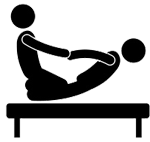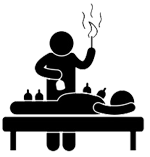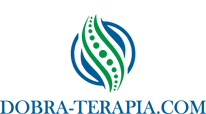The number of people with back problems, although difficult to estimate, is extremely large. Despite all this, still only few people know that there is a medical field called manual therapy that restores health very quickly. Fortunately, the number of those who have found relief through manual therapy is increasing, effectively reducing the ranks of patients.
According to specialists in this field, people suffering from spine ailments repeatedly undergo unnecessary spine surgeries. Often, one manual procedure is enough to eliminate discopathic symptoms, e.g. due to the so-called "A dropped disk".
If you found this page, 95% of the time it means that you probably suffer like many others. This article aims to introduce you to what manual therapy is and what it does, so that it can help you to live normally again.

What is manual therapy?
Chiropractic, or manual therapy, is a method of physiotherapeutic massages that dates back to ancient times. Its main activity is supporting the spine and joints. During the treatment, apart from classic massage, specialized grips, levers, manipulations and mobilization are used. Through these activities, the therapist is able to restore joint mobility, relieve pain and regain feeling. Our therapy is based on the skilful use of a range of different techniques. Chiropractic, klawiterapia, acupressure and cupping therapies are also part of the "good therapy", i.e. manual therapy used in our office.
What are the indications for using manual therapy?
This method is very effective in treating various pains and muscle disorders. The most common areas of action for manual therapists are the coccyx, sacro-lumbar, shoulder joints, neck, knees, and feet. Manual therapy is used for posture defects, scoliosis, hernias, migraines, sciatica, sleep disorders and many other ailments.
Manual action of the therapist stabilizes the patient's posture and generally allows avoiding sleepless nights, regular taking of painkillers or surgery.
What is chiropractic?
Chiropractic is a therapeutic field, but also an art. The chiropractor, through the appropriate manipulation of the body, tries to implode inside the joint, which in turn introduces intra-articular fluid inside. This action stimulates the body's natural ability to regenerate, and ultimately restores the balance of the patient's locomotor system. In our treatments, chiropractic is often a key element of the procedure, and other techniques are to prepare the patient well for it.

What is klawiterapia ?
Klawiteraia is a Polish rehabilitation art initiated by Professor Barbasiewicz. Using special devices called clavicles, the therapist awakens the lost nerve conduction by pressing the affected area, trigger points or the appropriate configuration (and the order of stimulation) of several such points at once (causing the so-called short circuits). This device, although it looks sharp, should not damage the patient's epidermis. Clavicles also stimulate very well on points related to acupressure.
What is cupping therapy?
Cupping therapy, derived from traditional Chinese medicine, is several thousand years old. This method consists in applying a cups to a selected place in the body, and then (or before applying) creating pressure in it. Sometimes the skin requires proper preparation before applying the cup or other actions are performed (moving, heating). We use several different types of cuppings in our office. The range of their activities is versatile. Among their applications are musculoskeletal system problems, joint pain, headache, muscle pain, cough, asthma and many others. A properly selected session based on cupings gives strong support in the comprehensive therapy of restoring the natural balance in the patient's body and builds the foundations for including other techniques used in our office.
Is manual therapy safe?
Manual therapy is a safe technique, but it requires prior consultation with a therapist about previous diseases, injuries or operations. It is worth taking the results of the tests (X-ray, MRI, ultrasound) with you.

Manual therapy and its scope
Manual therapy is derived from folk medicine, its scope covers the knowledge of several medical specialties, such as internal medicine, orthopedics, traumatology, neurology, rheumatology, and radiology. The synthesis of these specialties allows the manual therapist to eliminate numerous spinal and spinal ailments by the so-called "spine adjusting".
The healing possibilities that can be obtained in this way are still shrouded in mystery. In fact, chiropractic (this is how manual therapy is commonly called) has been functioning and developing around the world for many years as an inseparable branch of classical medicine. Currently, in Poland, many doctors, physiotherapists and masseurs have been trained in this specialty. Thanks to that, the mystery, mainly related to ignorance, is gradually dissipated, allowing manual therapy to gain more and more serious and due place in general medicine. It is amazing how wide the range of manual medicine activities is. It affects not only the spine, but the entire motor system. And that’s not all. Through the mutual anatomical and physiological relationships of all organs of the human body, the effectiveness of manual medicine achievessurprisingly good results in diseases that seemingly have nothing to do with the spine. These include: headaches and migraines, epilepsy, tinnitus, heart palpitation and arrhythmia, large fluctuations in blood pressure, or inflammation of the urinary tract.

Common health conditions
In manual therapy, even with such serious conditions as sciatica or herniated nucleus pulposus, pain symptoms usually disappear in one treatment, and complete recovery is ensured by several treatments performed within a few days.
Sciatica is an inflammation of the sciatic nerve, causing pain in the lumbar spine, buttocks, thighs, shins and feet - occurring simultaneously or individually in one of the areas. Most of these symptoms are recognized by doctors as inflammation of the sciatic nerve and treated with medication. Such treatment does not bring the desired effect because it does not remove the cause but only drowns out the symptoms.
This is where manual therapy comes in handy. The specificity of the procedure consists of restoring the correct position of the vertebrae, thus releasing the pressure on the nerves and the intervertebral disc, which was the actual cause of the pain. No painkillers, antispasmodics, or anti-inflammatory drugs are used. They can, at best temporarily overcome the effects of the disease.
Spine alignment treatment removes the root causes. A neurosurgeon would perform a spine surgery which would excise the tissues that compress the nerve, also removing the cause. In 90% of cases, surgery turns out to be unnecessary, and by setting the vertebrae correctly, thus restoring the proper mobility of the spine, all causes and symptoms are eliminated without surgery.
More about pain conditions
History of Manual Therapy

Manual therapy has its origins in the years 460 -377 BC, it is assumed that Hippocrates recognized the "shifting of the vertebrae" as the cause of many diseases. In Poland, as in many countries, manual therapy has its roots in folk medicine. The medical trend dates back to the beginning of the 20th century. Two publications are known from that period, 'Chiropractic as a new method of treatment' by Dr. Olgierd Krukowski and 'Chiropractic, the art of addressing dislocated vertebrae as the main cause of diseases' developed by Father M. Pawłowski, both published in 1926.
Manual medicine combines many medical specialties such as internal medicine, orthopedics, traumatology, neurology, rheumatology, and radiology. The manual therapist always tries to look at the whole, the synthesis of skills allows you to remove many spinal ailments through the so-called "spine adjusting".

Conclusions
The above article presents only a small part of the possibilities of manual therapy. However, these are the most common cases, thanks to which manual therapy is being talked about more and more often. This is especially emphasised thanks to people for whom backbone problems are just an unpleasant memory.
Therefore, dear reader, if you suffer from any of the above-mentioned ailments and want to deal with it, please contact us. We will certainly help.
List of some of the diseases:
- Sciatica
- painful shoulder
- radiating scapula pain
- medial humeral condyle damage
- knee pain
- wrist stiffness
- Balance disorders
- pain on the dorsal side of the forearm
- widow's hump
- numbness in the limbs
- scoliosis
- Torticollis
- Migraine
- dizziness
- zawroty głowy
- heel spurs, bunions
- sprains of the joints: ankle, knee, hip












